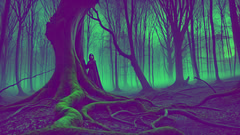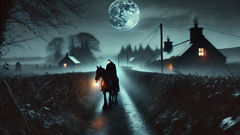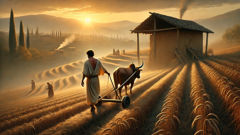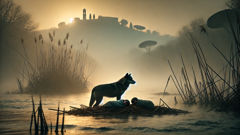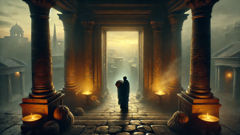Introduction
In the heart of medieval Poland, when the world was little more than a patchwork of shadowy woods and distant, flickering fires, the boundary between the known and the uncanny felt perilously thin. The ancient forests stretched for miles, their gnarled limbs twisting skyward like the fingers of old gods, while moss-clad stones and misty rivers whispered secrets only the wind could decipher. Villages—clusters of thatched roofs and wooden fences—clung to clearings in the wild, their people wary and vigilant. For every newborn's first cry and every old woman's last breath, there lingered a fear that something unearthly might be watching from the dark. Among the many legends that curled like smoke through these settlements, none gripped the collective heart with more icy fingers than the tale of the Strzyga—a female demon, born of a woman carrying two souls. Those marked at birth by an extra row of teeth, a split tongue, or eyes of mismatched color were eyed with suspicion, for it was believed such signs heralded a Strzyga in the making. If she died young, her second soul might rise, drifting through the world with a thirst for human blood, doomed to forever wander between the realms of the living and the dead. Children hushed each other with stories of the Strzyga, mothers scratched protective symbols above cradles, and priests muttered prayers as dusk fell. Yet, beneath the terror and superstition, there were those who questioned whether the curse was real or a mask for something more human—fear of the unknown, the outcast, the misunderstood. In the village of Barwinek, on the edge of a dense forest where wolves howled and strange lights glimmered in the marshes, a series of chilling events would soon force its people to confront the darkness within and without. Their struggle would reveal not only the true nature of the Strzyga but also the power of belief, redemption, and the indomitable strength of the human soul.
Whispers in Barwinek
Barwinek was a village where superstition grew as thick as the brambles that lined the edge of the forest. Wooden huts huddled together, their small windows glowing like watchful eyes, while the villagers lived tethered to ancient rituals. Each spring, offerings of bread and salt were left at the crossroads; each autumn, a festival was held to honor ancestors and plead for a mild winter. But beneath these customs simmered a constant anxiety, sharpened by stories that seemed always to begin with a birth, an omen, or a disappearance.
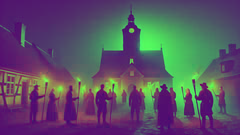
The year was 1372, and the last frost of winter clung stubbornly to the ground when tragedy struck. In the span of a single moon, three children fell ill. Their skin grew pallid, their eyes sunken. No amount of herbal poultices or whispered prayers could halt their decline. Fear spread faster than the sickness, and soon every cough in Barwinek was met with wary glances. Old women muttered that it was the work of a Strzyga. They recalled tales of a pale young woman—Marta, the miller’s daughter—who had died suddenly the previous autumn. She’d been born with eyes of two different colors and a strange mark above her heart. Though she’d always been quiet and gentle, many had looked at her askance, certain she was marked by the old curse.
Aniela, the village healer, refused to accept these whispers. Her own mother had taught her that fear could be as deadly as any sickness, and that not every misfortune was the work of demons. Still, even she felt a chill when she found the first child—little Wojtek—lying weak and feverish, two small puncture wounds barely visible on his neck. Rumors spread that Marta’s grave had been disturbed. Some claimed to see a pale shape moving in the fields at dusk, others heard strange cries echoing from the forest. Panic swelled; the villagers gathered nightly at the church, clutching crosses and muttering prayers until dawn.
One rain-soaked evening, as thunder rolled over the rooftops, Barwinek’s council convened. Their leader, Piotr, a stern man with a scar across his cheek, stood before the frightened crowd. He declared they would dig up Marta’s grave at sunrise. If she was truly a Strzyga, her corpse would be twisted and unspoiled, her mouth bloody with the lives she’d stolen. Only by burning her body, he insisted, could the curse be lifted. Aniela pleaded with them to wait, to seek reason, but her words fell on deaf ears. The hunger for certainty—any certainty—overpowered compassion.
That night, unable to sleep, Aniela wrapped herself in a wool cloak and slipped into the woods. She carried a lantern and a pouch of protective herbs. The forest loomed around her, every shadow seeming to watch. She followed the winding path toward the burial ground, her heart pounding. At Marta’s grave, she found the earth undisturbed—but something else caught her eye. Deep footprints, shaped like a woman’s but oddly elongated, led away into the thicket. She knelt and pressed her hand to the soil, feeling a strange cold seep through her skin. Something was out there—something that didn’t belong. Yet, Aniela sensed that it was not the vengeful spirit the villagers feared. Her search had only begun.
The Two Souls
As dawn bled over Barwinek, the villagers assembled at the graveyard. The air was thick with dread, and not even the songs of birds dared break the silence. The men took up shovels, their faces grim. Piotr gave the order, and soil flew in hurried handfuls. Aniela, standing apart, watched every movement, her hands balled into fists.

When the coffin emerged, there were murmurs. The wood was damp but intact. Piotr nodded to the priest, who began a prayer. Then the lid was pried open. Marta’s body lay within, pale and serene, her hair still gleaming like cornsilk. There was no blood on her lips, no monstrous contortions. Her hands, folded over her chest, bore no sign of violence or decay. For a moment, confusion rippled through the crowd.
But then old Babcia Zofia leaned forward and gasped. “Look at her eyes!” she cried. One eye was blue, the other green—a sign, she insisted, that her second soul still lingered. Fear flared anew. Piotr ordered the body to be burned. As they dragged Marta’s corpse from the coffin, Aniela stepped forward and blocked their path. “This is not justice,” she said, her voice steady despite the tremor in her heart. “This is fear. She has done nothing to harm us.”
Piotr sneered. “And yet our children lie dying. If not her, then what?”
Aniela shook her head. “If you burn her, you may never learn the truth.” But the villagers could not be swayed. The body was placed on a pyre, and as flames consumed it, smoke curled skyward, carrying with it a sense of finality—and unease. That night, the children’s fevers broke, but one—Wojtek—remained deathly weak.
Determined to uncover what truly haunted Barwinek, Aniela visited Wojtek’s family. The boy lay in a fever-dream, whispering of a woman who came to him at night—her face both beautiful and sorrowful. “She wept,” he murmured, “and asked for forgiveness.” Aniela pressed him gently, and Wojtek described how the woman spoke of being lost between worlds, longing only for peace.
Haunted by his words, Aniela delved into old scrolls in the church archives. She read of Strzygi—creatures said to be born with two souls: one human, one cursed. If denied rest in death, the second soul would wander, thirsting for life. But there were hints in the oldest tales that some Strzygi sought not blood, but release—a way to heal the rift within themselves.
That evening, Aniela took a risk. She walked alone into the woods and called out to the spirit she sensed lingered there. Mist gathered around her feet as the air grew cold. Out of the gloom stepped a figure—Marta, or what remained of her. Her form shimmered, insubstantial yet real enough for Aniela to see her mismatched eyes shining with pain and longing.
“I never wished them harm,” Marta’s spirit whispered. “The hunger is not mine—it is the wound left by their fear.” Aniela realized then that it was not Marta herself who fed on the living, but the villagers’ hatred and terror that kept her trapped between worlds. The legend of the Strzyga, born from fear and misunderstanding, had become a self-fulfilling curse.
With courage, Aniela promised to help Marta find peace. She would need to convince the villagers to let go of their fear and offer forgiveness. Only then could the curse be broken.
The Truth in Shadow
The days following Aniela’s encounter with Marta’s spirit were tense. The villagers, worn by weeks of fear and sleepless nights, clung to routine as a lifeline. Children no longer played after dusk; even the bravest hunters hesitated to enter the woods. Yet, word spread that Wojtek’s health was improving. Some saw this as proof that burning Marta’s body had ended the curse, but others—especially those who had noticed Aniela’s nightly absences—began to whisper.

Aniela met secretly with Father Tomasz, Barwinek’s priest. He listened to her account of Marta’s apparition with grave concern. “If what you say is true, then we have wronged her twice over—once in life, once in death,” he said. Together, they devised a plan to confront the village’s fear directly. At Sunday mass, Father Tomasz spoke not of damnation, but of forgiveness. He urged his flock to remember Marta’s kindness and to consider that perhaps their hatred had trapped her soul.
The villagers grumbled, but Aniela pressed on. She gathered a small group willing to listen and led them to the forest at dusk. They carried candles and wildflowers, symbols of remembrance and reconciliation. At the spot where Aniela had met Marta’s spirit, they knelt and offered prayers—not for deliverance from evil, but for peace to a restless soul.
As their voices mingled with the sighing wind, a cold shiver passed through the group. For a moment, Marta’s figure appeared among them—no longer frightening, but radiating a gentle sadness. She bowed her head in gratitude and faded into the mist. That night, a hush fell over Barwinek. The children slept peacefully; no one heard strange cries or saw ghostly shapes.
Days turned to weeks. Spring melted into summer. Crops grew green and strong, and laughter returned to the village. Aniela became both respected and resented—admired for her wisdom, but eyed warily by those who still feared what they couldn’t explain. Yet, she persevered, tending to the sick and teaching children not just old remedies but the value of compassion.
One evening, as fireflies blinked above the river, Piotr came to Aniela’s door. He was gaunt and tired, his face shadowed with regret. “I was wrong,” he admitted quietly. “I let my fear blind me. Can you forgive me?”
Aniela nodded. “We all carry two souls, Piotr. One of light, one of shadow. It is our choices that decide which leads.”
The myth of the Strzyga faded into memory, its power broken not by fire or steel, but by understanding. Yet, on certain misty nights, some said they glimpsed a pale shape among the trees—watching, guarding, no longer seeking vengeance but serving as a reminder: true evil was not always what people imagined. Sometimes, it was the cruelty bred by fear, and the healing came only when that darkness was faced with an open heart.
Conclusion
The legend of the Strzyga endures in Polish folklore—a chilling echo from an era when fear stalked every shadow. Yet, in Barwinek’s tale, we glimpse something deeper: a story not simply of monsters and curses, but of the harm that suspicion and ignorance can inflict on the innocent. The villagers learned that evil is rarely born from outward signs or strange births, but grows strongest when compassion is abandoned in favor of certainty and blame. Through Aniela’s courage and the village’s eventual embrace of forgiveness, the cycle of fear was broken, and both the living and the dead found peace. Even now, as wind stirs the Polish forests and moonlight brushes ancient stones, the myth of the Strzyga serves as both warning and comfort—a reminder that every soul contains darkness and light, and that redemption often begins with understanding those who seem most different from ourselves.

